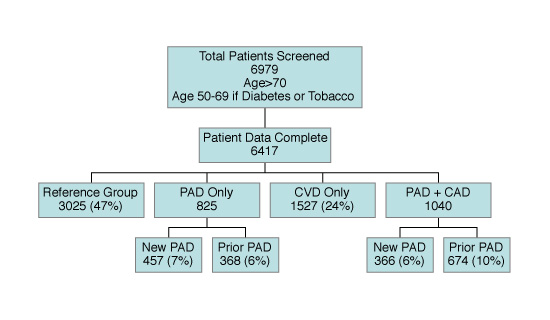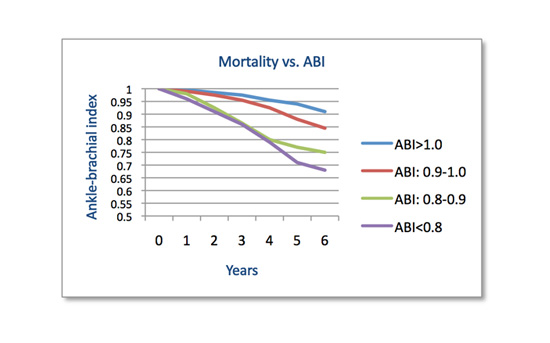| Home News and Events |

|
eCardioVascular BeatPeripheral vascular disease: reasons to care
Brad Evans, M.D.
Interventional cardiologist, Providence Portland Medical Center Jeff Logan, M.S.
Clinical exercise physiologist September was National Peripheral Vascular Disease Awareness Month. Do we care? The impacts of stroke and heart attack are both immediate and obvious. PVD, on the other hand, is quiet and insidious; it can be easily missed until it manifests as a stroke or heart attack. PVD has a surprisingly poor prognosis when compared to other diseases, yet it is relatively easy to identify. One of the largest screening studies for PVD to date was the PARTNERS study.1 This was a primary care office-based study in which 6,979 patients were screened with an ankle brachial index. Study patients were older than 70, or age 50 to 69 if they had additional risk factors such as diabetes or tobacco use.  This relatively simple screening algorithm brought several interesting findings. The prevalence of PVD in a primary care office was 29 percent. Surprisingly, 55 percent of the PVD diagnoses were previously unknown to the patient or the physician, and less than 10 percent of PVD patients noted classic symptoms. Perhaps less surprising is that patients who were previously not known to have PVD were less likely to have been counseled regarding smoking cessation and hyperlipidemia, and were less likely to be on any platelet agents. The screening test used in the PARTNERS study was the ankle-brachial index, a relatively simple test that involves using a Doppler probe and a blood pressure cuff. The index is calculated by comparing the highest brachial pressure to the highest of the dorsalis pedis or posterior tibial pressure in each limb. In general, an index of less than 1 is considered abnormal. The magnitude of the abnormality in the ankle-brachial index correlates well with poor prognosis, as demonstrated in the cardiovascular health study.2  Thus the late mortality of a patient with an abnormal ABI <.8 is of the same magnitude as some cancers, such as breast and colon cancer, both of which are aggressively screened. Of note, in a population of claudicants older than 55, the five-year mortality was 30 percent. The majority of this mortality (75 percent) was due to stroke and heart attack.3 Vascular disease screeningsProvidence Heart and Vascular Institute offers screenings for the most life-threatening vascular diseases:
Dr. Brad Evans will present a The ankle-brachial index is the screening tool of choice in the most recent American College of Cardiology and American Heart Association guidelines for treating PVD.4 Patients considered for screening are:
PVD often does not present in a typical fashion, and when it is missed there are fewer attempts at risk-factor modification. Mortality in patients with PVD is from stroke and heart attack. Thus, being unaware of PVD is a missed opportunity for earlier management of vascular disease and its complications. The ankle-brachial index is a simple test that can be performed in a variety of locations. When it is applied in the above recommended populations, the appropriate diagnosis can be made, making missed opportunities in PVD a thing of the past.
Other articles by Brad Evans, M.D. References
|
|||||||||||||||||
|
|||||||||||||||||
|
Copyright © 2024 Providence Health & Services. All rights reserved. Clinical Trials | Quality and Outcomes | News and Events | About Us | Contact Us | Make a Referral |
|||||||||||||||||